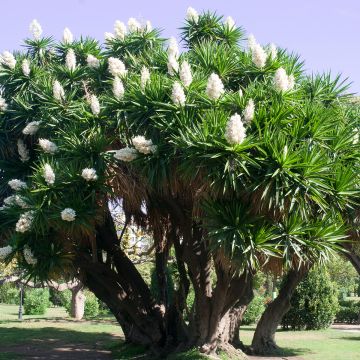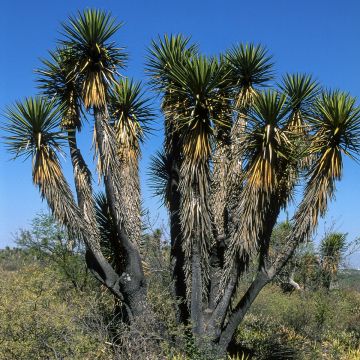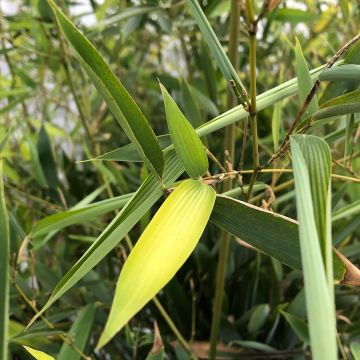

Yucca torreyi - Yucca de Torrey


Yucca torreyi - Yucca de Torrey


Yucca torreyi - Yucca de Torrey


Yucca torreyi - Yucca de Torrey
Yucca torreyi
Yucca torreyi
Torrey's Yucca, Faxon Yucca
There are major identification errors for this reference. Yucca Torreyi, Yucca Australis, and Yucca Faxoniana are three different species and not synonyms as you mention! What plant is it actually if I want to order?
hervé, 15/10/2024
Special offer!
Receive a €20 voucher for any order over €90 (excluding delivery costs, credit notes, and plastic-free options)!
1- Add your favorite plants to your cart.
2- Once you have reached €90, confirm your order (you can even choose the delivery date!).
3- As soon as your order is shipped, you will receive an email containing your voucher code, valid for 3 months (90 days).
Your voucher is unique and can only be used once, for any order with a minimum value of €20, excluding delivery costs.
Can be combined with other current offers, non-divisible and non-refundable.
Home or relay delivery (depending on size and destination)
Schedule delivery date,
and select date in basket
This plant carries a 24 months recovery warranty
More information
We guarantee the quality of our plants for a full growing cycle, and will replace at our expense any plant that fails to recover under normal climatic and planting conditions.
Would this plant suit my garden?
Set up your Plantfit profile →
Description
Yucca torreyi, given as a synonym of Yucca faxoniana or Yucca australis, over time forms a small tree with a single or multiple trunks, carrying skirts of dry, grey leaves. Each branching bears long, stiff leaves gathered in somewhat anarchic rosettes. The silhouette of this species, characteristic of arborescent yuccas in the desert regions of Mexico, is sometimes considered a bit disorderly. A disadvantage compensated by good resistance to cold, down to -15 °C (5 °F) in regions experiencing dry winters. A mature plant will offer beautiful oval and erect panicles adorned with large white flowers often touched with purple in summer. At least 12 years are necessary to obtain a beautiful specimen in open ground. Its hardiness allows it to be grown in open ground in many regions.
Yucca torreyi (or Y. faxoniana) is a plant from the agave family native to northeastern Mexico (Chihuahuan Desert), western Texas, and southeastern New Mexico. It comes from arid and semi-desert regions where frosts are occasional but can reach -15 °C (5 °F) at their peak.
Young Yucca faxoniana have the appearance of a rosette of stiff, linear leaves, 60 cm (24 in) to 1.4 m (5 ft) long and 4-5 cm (2 in) wide, with edges supplied with curly filaments, bluish-green and ending in a solid spine. The whole measures approximately 1.1 m (4 ft) in all directions and this vegetation persists in winter. After 10 to 12 years, the plant begins to form a trunk, sometimes followed by two or three others. The rosette gives rise over time to a few branches, each carrying a rosette of leaves. Older plants may show several branches diverging at acute angles. The living leaves are often arranged along the axial stem, forming an elongated rosette. The majority of leaves are erect, while a few others are implanted at different angles. The dead leaves, greyish-beige in colour, remain attached to the trunk for a long time. Ultimately, this yucca forms a small tree with a chandelier-like silhouette, reaching a height of 7 m (23 ft) with a spread of 3 to 4 m (10 to 13 ft). The trunks of mature specimens have a well-enlarged, swollen base. The decorative flowering occurs in July-August on very old plants. It takes the form of a large, erect panicle that protrudes from the foliage. This branched inflorescence bears white bell-shaped flowers, 6 to 10 cm (2 to 4 in) in diameter and slightly fragrant. In Mexico, yucca is pollinated by a night butterfly that does not live in Europe. To obtain fruits and seeds, manual pollination will therefore be necessary.
Yucca torreyi is an easy-to-grow exotic plant in well-drained soil. It is adapted to arid conditions and withstands dry cold very well. It should be kept a little away from walkways and young children due to its pointed leaves. This plant is perfect for structuring a large rock garden or for brilliantly occupying the centre of an exotic bed. It can be planted alone or combined with Puya caerulea, Agave americana, prickly pears, Beschorneria, and fairly hardy candelabra cacti (Cleistocactus strausii, Cylindropuntia imbricata), all equally undemanding. Growing it in pots is quite disappointing as it does not allow this yucca to reach its full potential.
Report an error about the product description
Yucca torreyi in pictures
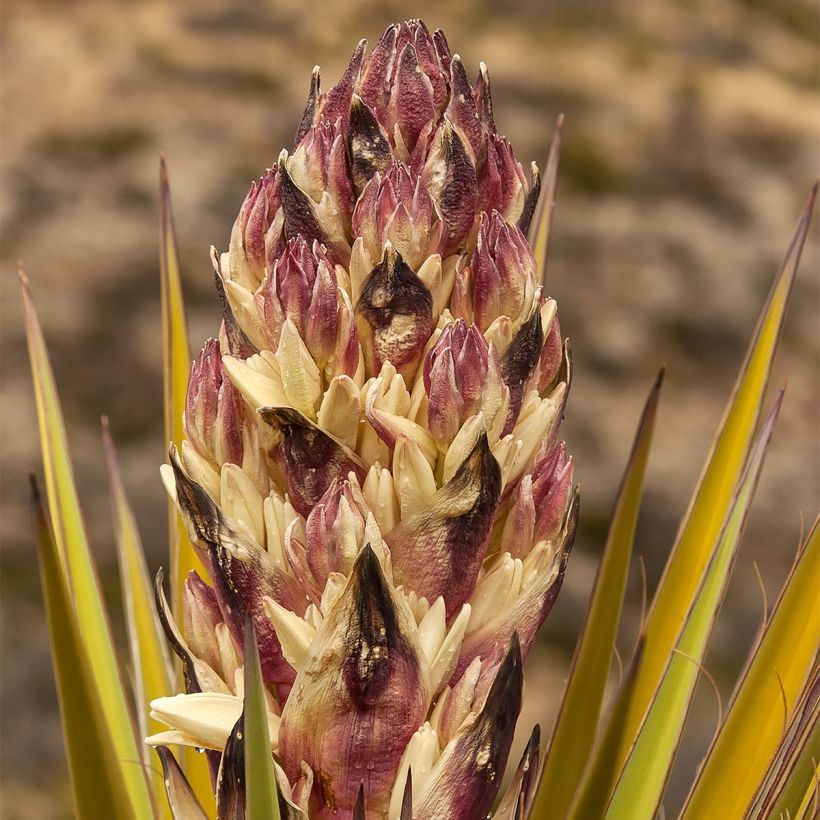

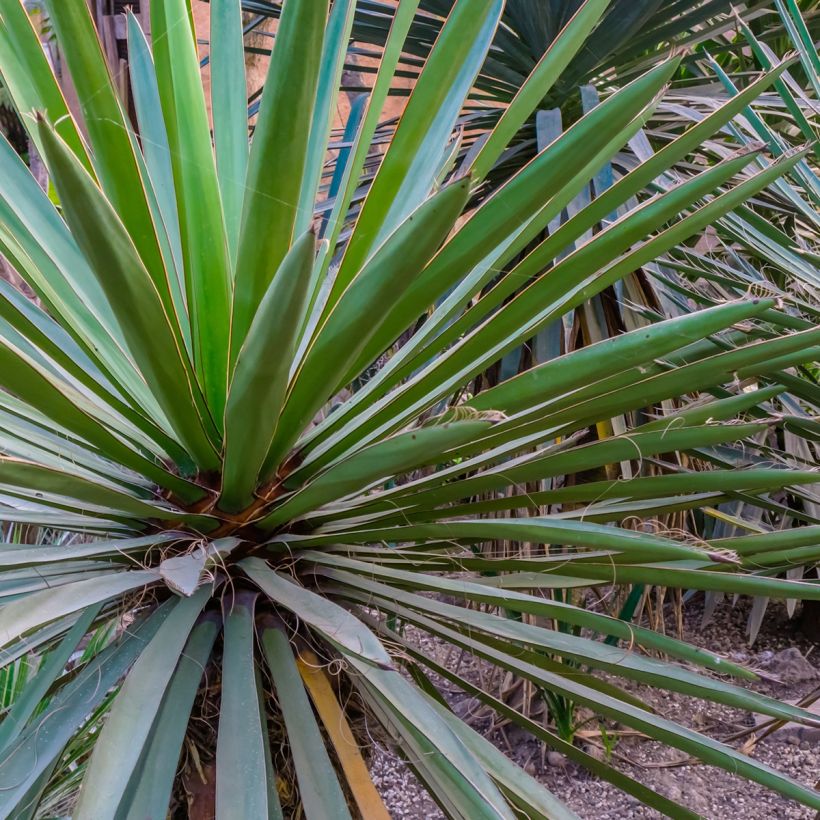



Plant habit
Flowering
Foliage
Botanical data
Yucca
torreyi
Agavaeae
Torrey's Yucca, Faxon Yucca
North America
Other Yucca
View all →Planting and care
Plant Yucca faxoniana in spring, in a very sunny location. In hot and dry climates, it is preferable to plant in early autumn. An adult specimen will withstand brief frosts of around -15 °C (5 °F), in well-drained or even dry soil. This species does not appreciate excess humidity, especially when combined with cold temperatures: place the plant in a slightly elevated position, in rocky or sandy soil. However, it is not picky about soil pH, which can be slightly acidic or slightly alkaline. This plant can tolerate poor soil, but its growth will be slightly faster in soil that is somewhat fertile. Monitor watering during the first 2 years, especially during hot and dry periods. Remove faded stems.
If your Yucca looks beautiful but does not flower, it is probably too young. Indeed, this plant takes time to establish itself and only flowers after many years. Then, depending on the amount of sunlight and the climate, it will flower every year, or every 2 or 3 years.
Propagation:
Yucca can easily be propagated by cutting sections of the trunk. It should be noted that plants propagated from cuttings produce fewer roots than those grown from seeds, making them susceptible to strong winds and less resistant to drought in hot climates.
Fertilisation in Yuccas:
In their countries of origin, Yucca flowers are pollinated only by a few species of tiny, primitive butterflies without proboscises that live in symbiosis with the plant, such as Prodoxus. The female of these butterflies carries pollen grains from one flower to the pistil of another. She lays a few eggs at the base of the flower. The young caterpillars feed on some of the seeds. Since Prodoxus is not part of our native fauna, most Yuccas grown in our gardens never produce fruits. Only Yucca aloifolia is capable of doing so, because its pollination does not depend on the presence of these microbutterflies.
Planting period
Intended location
Care
-
, onOrder confirmed
Reply from on Promesse de fleurs
Similar products
Haven't found what you were looking for?
Hardiness is the lowest winter temperature a plant can endure without suffering serious damage or even dying. However, hardiness is affected by location (a sheltered area, such as a patio), protection (winter cover) and soil type (hardiness is improved by well-drained soil).

Photo Sharing Terms & Conditions
In order to encourage gardeners to interact and share their experiences, Promesse de fleurs offers various media enabling content to be uploaded onto its Site - in particular via the ‘Photo sharing’ module.
The User agrees to refrain from:
- Posting any content that is illegal, prejudicial, insulting, racist, inciteful to hatred, revisionist, contrary to public decency, that infringes on privacy or on the privacy rights of third parties, in particular the publicity rights of persons and goods, intellectual property rights, or the right to privacy.
- Submitting content on behalf of a third party;
- Impersonate the identity of a third party and/or publish any personal information about a third party;
In general, the User undertakes to refrain from any unethical behaviour.
All Content (in particular text, comments, files, images, photos, videos, creative works, etc.), which may be subject to property or intellectual property rights, image or other private rights, shall remain the property of the User, subject to the limited rights granted by the terms of the licence granted by Promesse de fleurs as stated below. Users are at liberty to publish or not to publish such Content on the Site, notably via the ‘Photo Sharing’ facility, and accept that this Content shall be made public and freely accessible, notably on the Internet.
Users further acknowledge, undertake to have ,and guarantee that they hold all necessary rights and permissions to publish such material on the Site, in particular with regard to the legislation in force pertaining to any privacy, property, intellectual property, image, or contractual rights, or rights of any other nature. By publishing such Content on the Site, Users acknowledge accepting full liability as publishers of the Content within the meaning of the law, and grant Promesse de fleurs, free of charge, an inclusive, worldwide licence for the said Content for the entire duration of its publication, including all reproduction, representation, up/downloading, displaying, performing, transmission, and storage rights.
Users also grant permission for their name to be linked to the Content and accept that this link may not always be made available.
By engaging in posting material, Users consent to their Content becoming automatically accessible on the Internet, in particular on other sites and/or blogs and/or web pages of the Promesse de fleurs site, including in particular social pages and the Promesse de fleurs catalogue.
Users may secure the removal of entrusted content free of charge by issuing a simple request via our contact form.
The flowering period indicated on our website applies to countries and regions located in USDA zone 8 (France, the United Kingdom, Ireland, the Netherlands, etc.)
It will vary according to where you live:
- In zones 9 to 10 (Italy, Spain, Greece, etc.), flowering will occur about 2 to 4 weeks earlier.
- In zones 6 to 7 (Germany, Poland, Slovenia, and lower mountainous regions), flowering will be delayed by 2 to 3 weeks.
- In zone 5 (Central Europe, Scandinavia), blooming will be delayed by 3 to 5 weeks.
In temperate climates, pruning of spring-flowering shrubs (forsythia, spireas, etc.) should be done just after flowering.
Pruning of summer-flowering shrubs (Indian Lilac, Perovskia, etc.) can be done in winter or spring.
In cold regions as well as with frost-sensitive plants, avoid pruning too early when severe frosts may still occur.
The planting period indicated on our website applies to countries and regions located in USDA zone 8 (France, United Kingdom, Ireland, Netherlands).
It will vary according to where you live:
- In Mediterranean zones (Marseille, Madrid, Milan, etc.), autumn and winter are the best planting periods.
- In continental zones (Strasbourg, Munich, Vienna, etc.), delay planting by 2 to 3 weeks in spring and bring it forward by 2 to 4 weeks in autumn.
- In mountainous regions (the Alps, Pyrenees, Carpathians, etc.), it is best to plant in late spring (May-June) or late summer (August-September).
The harvesting period indicated on our website applies to countries and regions in USDA zone 8 (France, England, Ireland, the Netherlands).
In colder areas (Scandinavia, Poland, Austria...) fruit and vegetable harvests are likely to be delayed by 3-4 weeks.
In warmer areas (Italy, Spain, Greece, etc.), harvesting will probably take place earlier, depending on weather conditions.
The sowing periods indicated on our website apply to countries and regions within USDA Zone 8 (France, UK, Ireland, Netherlands).
In colder areas (Scandinavia, Poland, Austria...), delay any outdoor sowing by 3-4 weeks, or sow under glass.
In warmer climes (Italy, Spain, Greece, etc.), bring outdoor sowing forward by a few weeks.





































